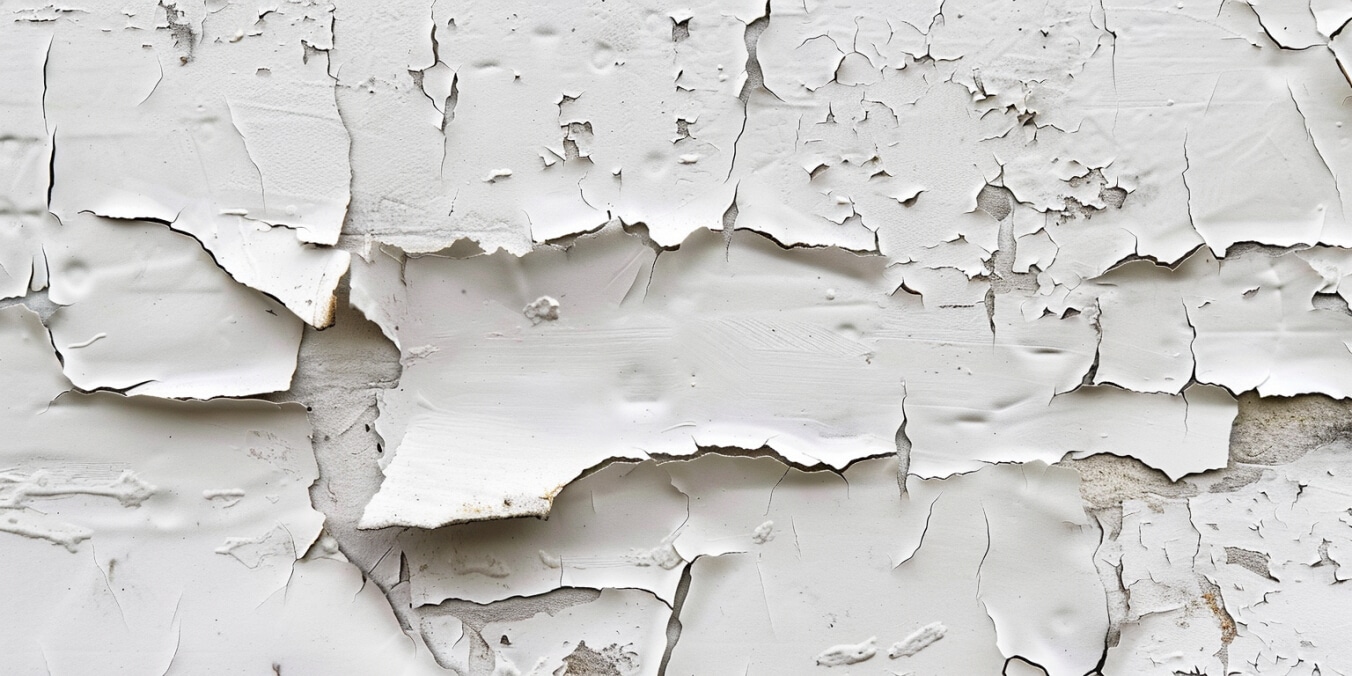Peeling paint on your ceiling can be more than just an eyesore; it can also point to underlying issues that need your attention. Ceiling paint peeling is a common home maintenance issue that many homeowners face, especially as their home starts to age.
In London, Ontario, and the surrounding areas, this issue is quite prevalent due to the varying climate conditions. Understanding the root causes of paint peeling is key to effectively addressing and preventing this problem, saving you time, effort, and frustration in the long run.
There are a variety of paint peeling causes, and each one tells a story about what’s happening in your home. From moisture issues to improper surface preparation, tackling these paint problems helps maintain a beautiful, inviting space for your family and guests. Repairing peeling paint may seem straightforward, but without addressing the underlying issues, the problem can return again and again. So, let’s get to the bottom of it together and keep your ceilings looking great!
By learning what causes ceiling paint to peel, you can achieve a better ceiling painting project. Also, you can take the proper steps to prevent it from happening in the first place. And that means fewer disruptions and more time enjoying the beautiful, well-maintained home you love.
Table of Contents
Why Is Ceiling Paint Peeling?
If you’ve noticed ceiling paint peeling, you’re probably wondering why it’s happening. The primary causes of damaged ceiling paint often include moisture in ceilings, improper painting techniques, and environmental factors. Moisture is one of the biggest culprits, whether it’s due to a leaky roof, condensation, or plumbing issues above the ceiling. Moisture can weaken the bond between the paint and the surface, leading to peeling over time.
Improper painting techniques are another major cause of peeling ceiling paint. This includes poor surface preparation, such as not cleaning or priming the surface before painting, or using low-quality paint that doesn’t adhere well. Environmental factors, like high humidity or drastic temperature changes, can also contribute to the problem, causing the paint to lose its grip and start to peel.
The general paint repair process involves removing the peeling paint, smoothing the surface, and repainting it correctly. To ensure a lasting solution, it’s crucial to address the root cause first—whether that means fixing a leak or improving ventilation. In London, Ontario, addressing these issues effectively can make a significant difference in maintaining the quality of your home. Once the underlying issue is solved, you can confidently proceed with repairing the peeling paint, restoring your ceiling to its original beauty.
By understanding these peeling ceiling paint causes and taking the appropriate steps, you can find effective paint peeling solutions that help keep your home looking its best.
Peeling Paint on the Ceiling Is Not Ideal
Peeling paint on the ceiling is more than just an unsightly ceiling paint problem—it can significantly impact your home’s aesthetics, cleanliness, and even safety. When paint starts peeling, it detracts from the overall appearance of your space, making it look neglected or poorly maintained. This can be frustrating, especially when you take pride in your home’s appearance and want to make it inviting for family and guests.
Beyond aesthetics, there are also health risks from paint dust and falling paint chips. Damaged ceiling paint can create dust particles, which may pose health concerns, particularly for individuals with respiratory issues. Additionally, falling paint can be a hazard, especially in areas where children or pets are present.
Another significant concern is how peeling paint can affect your home’s value. In London, Ontario’s competitive real estate market, the condition of your ceilings can greatly impact potential buyers’ perceptions and the overall value of your property. Potential buyers or guests may see paint peeling as a sign of poor upkeep or larger underlying issues, which can reduce the perceived value of your property. In some cases, peeling paint can even indicate structural damage if moisture or leaks are involved, leading to more serious ceiling repair concerns down the line.
Addressing these paint peeling risks is essential not only for maintaining the beauty of your home but also for ensuring the safety and health of your family. By taking action to repair peeling paint and prevent it in the future, you can protect both your investment and your loved ones.
What Are the Common Causes of Ceiling Paint Peeling?
There are several common causes of ceiling paint peeling, and understanding them can help you take the right steps to address the issue. Moisture damage in ceilings is one of the leading causes, particularly in rooms like bathrooms and kitchens where humidity levels are higher. Leaky pipes, condensation, or even roof leaks can lead to moisture buildup, which weakens the paint’s adhesion and eventually causes it to peel. Bathroom paint peeling is especially common due to the consistent exposure to steam and humidity.
Another major cause is improper painting techniques. Poor surface preparation, such as failing to clean or prime the ceiling properly, can result in weak adhesion. Low-quality or expired paint can also contribute to peeling, as it doesn’t bond well to the surface and is more prone to failure. In addition, temperature fluctuations can cause the paint to expand and contract, leading to cracking and peeling over time.
Other factors that contribute to peeling ceiling paint include soap scum from showers, smoke damage from cooking or candles, and applying excess paint layers without allowing proper drying time. These issues can all add to ceiling maintenance problems and reduce the longevity of your paint job.
To prevent these common causes of paint peeling, it’s important to control moisture levels, use high-quality paint, and ensure proper surface preparation before painting. By taking these steps, you can minimize the risk of peeling and keep your ceiling looking fresh and well-maintained.
Preventing Ceiling Paint Peeling
Preventing ceiling paint peeling starts with taking proactive measures to protect your ceilings from common causes of damage. In London, Ontario, where humidity can fluctuate, taking these measures is especially important to maintain a beautiful home. Moisture control is one of the most important steps you can take. In areas like bathrooms and kitchens, using exhaust fans can help reduce moisture levels and prevent condensation from accumulating on your ceilings. Proper ventilation is key to minimizing the risk of moisture damage in ceilings.
Another crucial step is ensuring that the surface is properly cleaned and primed before painting. Cleaning the ceiling thoroughly and applying a suitable primer will help create a strong bond between the paint and the surface, reducing the chances of peeling. When it comes to painting, always choose high-quality paint that is compatible with your ceiling material. High-quality paint is more durable and better suited to withstand environmental factors like humidity and temperature changes, which can cause paint damage over time.
Climate control also plays a role in preventing paint peeling. Maintaining a consistent temperature and humidity level in your home can prevent drastic fluctuations that may lead to paint cracking or peeling. This is particularly important in rooms that experience frequent changes in temperature, such as attics or sunrooms.
By following these ceiling maintenance tips and making informed choices about the materials and methods you use, you can effectively prevent paint peeling and keep your ceilings in great condition. Preventing paint damage is all about being proactive—addressing potential issues before they become problems helps you maintain a beautiful, well-cared-for home.
How to Fix Peeling Paint on a Ceiling
If you’re dealing with peeling paint, fixing it properly is key to ensuring the problem doesn’t return. Here’s a step-by-step guide to help you through the ceiling repair process and achieve a lasting finish:
- Remove the Peeling Paint: Start by scraping away all the loose, peeling paint using a putty knife or paint scraper. Be sure to remove any paint that’s not adhering well to the ceiling surface to create a solid base for the new paint.
- Address Underlying Issues: Before moving forward, identify and fix any underlying issues causing the peeling. This could include moisture problems, like a leaky pipe or poor ventilation. Solving these issues first will help prevent future paint peeling.
- Sand the Surface: After removing the peeling paint, sand the entire area using medium-grit sandpaper. This will smooth out rough edges and create a slightly rough surface that helps the new paint adhere better. Be sure to wipe away any dust with a damp cloth after sanding.
- Apply Primer: Priming the surface is crucial to achieving a durable finish. Use a high-quality primer that’s suitable for the ceiling material and any moisture-prone areas. Apply an even coat and allow it to dry completely before moving on to the next step.
- Repaint the Ceiling: Once the primer is dry, repaint the ceiling using high-quality paint. It’s important to use paint that’s specifically designed for ceilings and, if applicable, moisture-resistant paint for areas like bathrooms or kitchens. Apply two coats for best results, allowing each coat to dry thoroughly before adding the next.
- Use Proper Tools and Materials: To ensure a professional finish, use the right tools, such as quality paint brushes or rollers designed for ceiling applications. This helps to create a smooth, even coat without streaks or roller marks.
By following these ceiling repair steps and using proper tools and materials, you can effectively fix peeling paint and enjoy a ceiling that looks as good as new. Taking the time to do the job right will provide you with a long-lasting solution and prevent the frustration of dealing with recurring peeling paint problems.
You should read: Pro Tips for Painting Ceilings
Why Choose RGB for Your Ceiling Paint Project?
When it comes to fixing peeling paint and maintaining the beauty of your ceilings, RGB House Painters is the best choice for the job. Our team understands the root causes of paint peeling and is equipped with the expertise to tackle the underlying issues, ensuring a long-lasting solution. We take a comprehensive approach, addressing moisture control, proper surface preparation, and using high-quality materials to deliver results that stand the test of time.
With us, you benefit from professional, friendly, and caring service that minimizes disruptions to your busy life. We know how important it is for you to have a beautiful, well-maintained home that you can be proud of, and our experienced team is dedicated to making that happen. Whether it’s a minor repair or a complete ceiling repaint, we use the right tools, techniques, and premium paints to give you a flawless finish.
By choosing RGB, you’re not only getting a professional ceiling repair, but you’re also gaining peace of mind knowing that the job will be done right the first time. Our creative approach ensures that your ceilings are not just functional but also add to the overall aesthetics of your space. Let us help you restore and enhance the beauty of your home—whether you’re in London, Ontario, or a nearby community, so you can spend less time worrying about peeling paint and more time enjoying your inviting, well-cared-for space.




